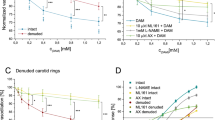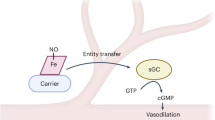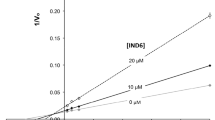Abstract
Beyond serving as a mechanical barrier, the endothelium has important regulatory functions. The discovery of nitric oxide1 revolutionized our understanding of vasoregulation. In contrast, the identity of endothelium-derived vasoconstrictive factors (EDCFs) remains unclear. The supernatant obtained from mechanically stimulated human endothelial cells obtained from dermal vessels elicited a vasoconstrictive response in an isolated perfused rat kidney. A purinoceptor blocker had a greater effect than an endothelin receptor blocker in decreasing endothelially derived vasoconstriction in the isolated perfused rat kidney. The nucleotide uridine adenosine tetraphosphate (Up4A) was isolated from the supernatant of stimulated human endothelium and identified by mass spectrometry. Up4A is likely to exert vasoconstriction predominantly through P2X1 receptors, and probably also through P2Y2 and P2Y4 receptors. Plasma concentrations of Up4A that cause vasoconstriction are found in healthy subjects. Stimulation with adenosine 5′-triphosphate (ATP), uridine 5′-triphosphate (UTP), acetylcholine, endothelin, A23187 and mechanical stress releases Up4A from endothelium, suggesting that Up4A contributes to vascular autoregulation. To our knowledge, Up4A is the first dinucleotide isolated from living organisms that contains both purine and pyrimidine moieties. We conclude that Up4A is a novel potent nonpeptidic EDCF. Its vasoactive effects, plasma concentrations and its release upon endothelial stimulation strongly suggest that Up4A has a functional vasoregulatory role.
This is a preview of subscription content, access via your institution
Access options
Subscribe to this journal
Receive 12 print issues and online access
$209.00 per year
only $17.42 per issue
Buy this article
- Purchase on Springer Link
- Instant access to full article PDF
Prices may be subject to local taxes which are calculated during checkout



Similar content being viewed by others
References
Palmer, R.M., Ferrige, A.G. & Moncada, S. Nitric oxide release accounts for the biological activity of endothelium-derived relaxing factor. Nature 327, 524–526 (1987).
Jankowski, J., Potthoff, W., Zidek, W. & Schlüter, H. Purification of chemically synthesised dinucleoside(5′,5′) polyphosphates by displacement chromatography. J. Chromatogr. B. Biomed. Sci. Appl. 719, 63–70 (1998).
Kasakov, L. & Burnstock, G. The use of the slowly degradable analog, alpha, beta-methylene ATP, to produce desensitisation of the P2-purinoceptor: effect on non-adrenergic, non-cholinergic responses of the guinea-pig urinary bladder. Eur. J. Pharmacol. 86, 291–294 (1982).
Bo, X., Sexton, A., Xiang, Z., Nori, S.L. & Burnstock, G. Pharmacological and histochemical evidence for P2X receptors in human umbilical vessels. Eur. J. Pharmacol. 353, 59–65 (1998).
Kunapuli, S.P. & Daniel, J.L. P2 receptor subtypes in the cardiovascular system. Biochem. J. 336, 513–523 (1998).
Wang, L. et al. P2 receptor expression profiles in human vascular smooth muscle and endothelial cells. J. Cardiovasc. Pharmacol. 40, 841–853 (2002).
Pulvirenti, T.J. et al. P2X (purinergic) receptor redistribution in rabbit aorta following injury to endothelial cells and cholesterol feeding. J. Neurocytol. 29, 623–631 (2000).
Nori, S., Fumagalli, L., Bo, X., Bogdanov, Y. & Burnstock, G. Coexpression of mRNAs for P2X1, P2X2 and P2X4 receptors in rat vascular smooth muscle: an in situ hybridization and RT-PCR study. J. Vasc. Res. 35, 179–185 (1998).
Turner, C.M., Vonend, O., Chan, C., Burnstock, G. & Unwin, R.J. The pattern of distribution of selected ATP-sensitive P2 receptor subtypes in normal rat kidney: an immunohistological study. Cells Tissues Organs 175, 105–117 (2003).
North, R.A. Molecular physiology of P2X receptors. Physiol. Rev. 82, 1013–1067 (2002).
King, B.F. et al. Diinosine pentaphosphate (Ip5I) is a potent antagonist at recombinant rat P2X1 receptors. Br. J. Pharmacol. 128, 981–988 (1999).
Lewis, C.J., Surprenant, A. & Evans, R.J. 2',3¢-O-(2,4,6- trinitrophenyl) adenosine 5′-triphosphate (TNP-ATP)-a nanomolar affinity antagonist at rat mesenteric artery P2X receptor ion channels. Br. J. Pharmacol. 124, 1463–1466 (1998).
Honore, P. et al. TNP-ATP, a potent P2X3 receptor antagonist, blocks acetic acid-induced abdominal constriction in mice: comparison with reference analgesics. Pain 96, 99–105 (2002).
Vial, C. & Evans, R.J. P2X(1) receptor-deficient mice establish the native P2X receptor and a P2Y6-like receptor in arteries. Mol. Pharmacol. 62, 1438–1445 (2002).
Burnstock, G. Purinergic signaling and vascular cell proliferation and death. Arterioscler. Thromb. Vasc. Biol. 22, 364–373 (2002).
Burnstock, G. Release of vasoactive substances from endothelial cells by shear stress and purinergic mechanosensory transduction. J. Anat. 194, 335–342 (1999).
Gorman, M.W., Marble, D.R., Ogimoto, K. & Feigl, E.O. Measurement of adenine nucleotides in plasma. Luminescence 18, 173–181 (2003).
Lazarowski, E.R. & Boucher, R.C. UTP as an extracellular signaling molecule. News Physiol. Sci. 16, 1–5 (2001).
Traut, T.W. Physiological concentrations of purines and pyrimidines. Mol. Cell. Biochem. 140, 1–22 (1994).
van der Giet, M. et al. The critical role of adenosine and guanosine in the affinity of dinucleoside polyphosphates to P(2x)-receptors in the isolated perfused rat kidney. Br. J. Pharmacol. 132, 467–474 (2001).
Barnes, L.D., Robinson, A.K., Mumford, C.H. & Garrison, P.N. Assay of diadenosine tetraphosphate hydrolytic enzymes by boronate chromatography. Anal. Biochem. 144, 296–304 (1985).
Nofer, J.R. et al. HDL induces NO-dependent vasorelaxation via the lysophospholipid receptor S1P3. J. Clin. Invest. 113, 569–581 (2004).
Acknowledgements
We thank M. Witt for accumulation of the FT-ICR mass spectra. We thank L. Lebeau for the gift of the internal standard. This study was supported by a grant of the Deutsche Forschungsgemeinschaft (Zi 315/15–1) and by a grant of the Hospal Research Funding (J. Jankowski).
Author information
Authors and Affiliations
Corresponding author
Ethics declarations
Competing interests
The authors declare no competing financial interests.
Supplementary information
Rights and permissions
About this article
Cite this article
Jankowski, V., Tölle, M., Vanholder, R. et al. Uridine adenosine tetraphosphate: a novel endothelium- derived vasoconstrictive factor. Nat Med 11, 223–227 (2005). https://doi.org/10.1038/nm1188
Received:
Accepted:
Published:
Issue Date:
DOI: https://doi.org/10.1038/nm1188
This article is cited by
-
A new advanced cellular model of functional cholinergic-like neurons developed by reprogramming the human SH-SY5Y neuroblastoma cell line
Cell Death Discovery (2024)
-
Purinoceptor: a novel target for hypertension
Purinergic Signalling (2023)
-
Indoxyl sulfate decreases uridine adenosine tetraphosphate–induced contraction in rat renal artery
Pflügers Archiv - European Journal of Physiology (2022)
-
Prevention of vascular calcification by the endogenous chromogranin A-derived mediator that inhibits osteogenic transdifferentiation
Basic Research in Cardiology (2021)
-
Impaired UTP-induced relaxation in the carotid arteries of spontaneously hypertensive rats
Purinergic Signalling (2020)



